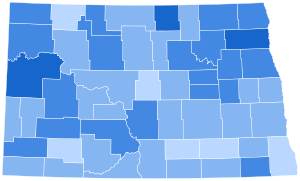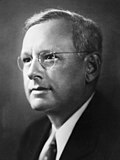| |||||||||||||||||||||||||||||||||
| |||||||||||||||||||||||||||||||||
 County Results
Roosevelt 40-50% 50-60% 60-70% 70-80%
| |||||||||||||||||||||||||||||||||
| Elections in North Dakota |
|---|
 |
The 1936 United States presidential election in North Dakota took place on November 3, 1936, as part of the 1936 United States presidential election. Voters chose four representatives, or electors to the Electoral College, who voted for president and vice president.
Ever since statehood, North Dakota had been overwhelmingly Republican at state level and in many presidential elections,[1] although progressive Democrat Woodrow Wilson was able to carry the state in both his campaigns in 1912 and 1916, in the second due to his anti-war platform. In the following three elections, the state's voting would be shaped by its extreme isolationism in the aftermath of President Wilson's pushing of the nation into World War I and his “League of Nations” proposal, to which the Russian-Germans who dominated North Dakota's populace were vehemently opposed.[2] North Dakota thus shifted markedly from voting four-to-one for Warren G. Harding against the pro-League James M. Cox in 1920, to being the second-strongest state for Robert La Follette under the Nonpartisan League banner in 1924, to strong pro-Catholic and anti-Prohibition voting for Al Smith in 1928. Severe drought and depression in the following three years turned the state overwhelmingly to Franklin D. Roosevelt in 1932, despite President Hoover's call to “be safe” by supporting him, and at the same time North Dakota elected progressive, pro-New Deal Republicans to fill its House and Senate seats.[3] One of these, Gerald Nye, would say in 1934 that the GOP needed to
turn its back up “that which has been its undoing, namely the private money bags”.[4]
Roosevelt won North Dakota by a margin of 33.02 percentage points and for the second consecutive election carried every county in the state. As of the 2020 presidential election[update], this is the last time that a Democratic presidential candidate has carried every county in the state (which previously occurred in 1932 as well). This is also the last time one has carried the following counties: Golden Valley, Grant, Kidder, Logan, McIntosh, Mercer and Sheridan.[5]
- ^ Hansen, John Mark; Shigeo Hirano, and Snyder, James M. Jr.; ‘Parties within Parties: Parties, Factions, and Coordinated Politics, 1900-1980’; in Gerber, Alan S. and Schickler, Eric; Governing in a Polarized Age: Elections, Parties, and Political Representation in America, pp. 143-159 ISBN 978-1-107-09509-0
- ^ Lubell, Samuel; The Future of American Politics (1956), pp. 156-164
- ^ Grant, Michael Johnston; Francis, Charles A. and Flora, Cornelia; Down and Out on the Family Farm: Rural Rehabilitation in the Great Plains, 1929-1945, pp. 69-70 ISBN 9780803271050
- ^ Sheppard, Si; The Buying of the Presidency? Franklin D. Roosevelt, the New Deal, and the Election of 1936, p. 25 ISBN 9781440831058
- ^ Sullivan, Robert David; ‘How the Red and Blue Map Evolved Over the Past Century’; America Magazine in The National Catholic Review; June 29, 2016
© MMXXIII Rich X Search. We shall prevail. All rights reserved. Rich X Search



